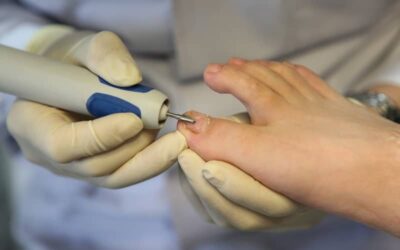If you just hurt your ankle, you might have a lot of questions. Is it sprained? What does that mean? What can I do to help it? When can I play sports again? This guide will help you learn everything you need to know about sprained ankles.
What is a Sprained Ankle?
A sprained ankle happens when the ligaments in the ankle are pulled beyond their typical capacity, which can cause the ligament to stretch or even tear. Ankles sprain when the foot lands incorrectly or it twists or turns awkwardly. You may or may not hear a loud pop.
Many ankle sprains occur during sports, but they can happen any time the ankle is twisted. You can twist your ankle scoring the winning goal or doing something much more mundane, such as tripping on stairs, walking on uneven sidewalk, or being tackled by your dog.
Symptoms of a Sprained Ankle
Right after the incident, you might begin feeling pain in your ankle. In addition to pain, you might experience:
- Bruising
- Swelling
- Tenderness
- Decreased mobility
- Instability on your ankle
Is it Sprained or Broken?
You might (rightly) be worried that your ankle injury is actually a broken bone. Here are some ways to determine whether the ankle is sprained or broken:
- Sound: If you heard a popping sound at the time of an injury, it is most likely sprained. If you hear a crack, it is most likely fractured or broken.
- Feel: If your ankle hurts, you most likely have a sprain. If your ankle feels numb or tingly, you most likely have a broken bone.
- Look: You will experience swelling with both a sprain and a break. However, if the ankle doesn’t seem aligned correctly or looks off, it is probably more than a sprain.
- Location: Where the pain is located can help you know what is happening under the skin. If your pain is more located in the soft part of the ankle, you probably have a sprain. You might have a fracture if you have more pain directly above the ankle bone.
If you still can’t determine on your own whether you have a sprained or broken ankle, you will need an x-ray.
How to Treat a Sprained Ankle
Sprained ankle pain treatment will depend on the severity of the sprain. A mild sprain can be treated with over-the-counter pain medication, while a more serious sprain may require a trip to a doctor.
Other steps to treat your sprained ankle might include:
- Rest. Taking a break from sports can be challenging, but allowing your injury to heal fully is the best thing you can do to avoid further complications.
- Ice. Putting ice on your ankle for 20-minute stretches every couple of hours will help keep the pain at bay and the swelling to a minimum.
- Heat. After swelling goes down, heating compresses can also help alleviate pain.
- Elastic bandage. Wrapping the ankle in a bandage or sleeve can help stabilize the ligaments.
- Elevation. Raising the ankle can help reduce swelling.
- Exercises. Don’t do these prematurely; stretching exercises can help return mobility to your ankle once the swelling subsides. Once you can tolerate stretching exercises, and before you return to regular activity, strengthening exercises can help you prevent re-injuring your ankle.
When can I Return to Sports?
If your injury is sport-related, you may be anxious to get back on the court or field. Before you suit up, make sure you meet these guidelines:
- You can bear weight without limping
- The ankle is no longer swollen
- You have a full range of motion
- The sport does not cause pain
- Your doctor gives you his or her approval
Risk Factors for Future Sprained Ankles
Once you sprain your ankle, you are more susceptible to future ankle sprains. Other risk factors may increase your risk of a sprained ankle, including:
- Wearing Incorrect Footwear. If the shoes you are wearing aren’t designed for the sport you are playing, you might be asking for an injury. Even wearing shoes that are too old or worn can increase your risk of an ankle injury. If you are a runner, you should be breaking in new shoes every 300 to 500 miles. That may seem excessive when they still look new, but the shock absorption on them is not as effective.
- Being out of Shape. If you are just returning to exercising, you are at a higher risk of injuring your ankle. Your muscles and ligaments won’t be as strong if it’s been a long time since you’ve been active. Ease into a new exercise routine to strengthen your muscles because jumping right back into a full exercise regimen can cause you to do too much too fast.
- Uneven Surfaces. If you regularly run on trails, walk on uneven surfaces, or play a sport on an uneven field, you have a higher risk of spraining your ankle. If your foot does not have a solid, flat surface to land on, it will be hard to keep your ankles healthy.
- Sports with Twisting. Participating in sports with a lot of twisting and jumping, such as basketball, football, soccer, and tennis, all increase your risk of a sprained ankle.
Preventing Future Sprains
You can take some precautions to avoid spraining your ankle again in the future. Here are the best ways to prevent sprains:
- Use caution any time you walk, run, or play on uneven surfaces.
- Warm up before any physical activity or sport.
- Stretch your ankles regularly to keep the muscles and ligaments flexible.
- Choose your footwear wisely.
- Do ankle strengthening and range of motion exercises.
- Use an ankle brace, tape, or high-top shoes to provide additional support to the ankle.
- Avoid high heels.
- Listen to your body. Don’t overdo it. If you get tired, you are more likely to make sloppy moves, increasing your risk of getting hurt.
If you are experiencing ankle pain and want a certified foot and ankle specialist to check out your sprain, call our St. George, Utah, or Mesquite, Nevada, offices to schedule an appointment today.



